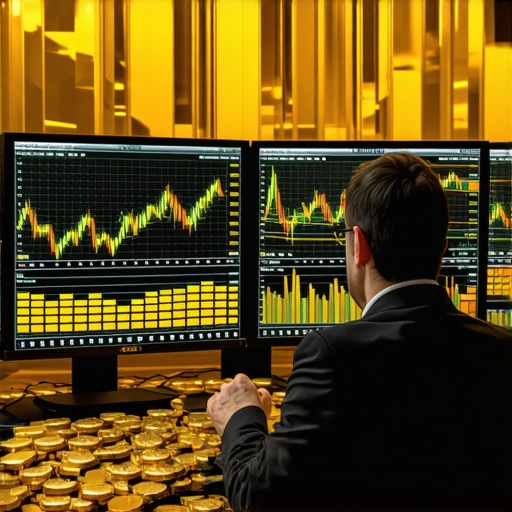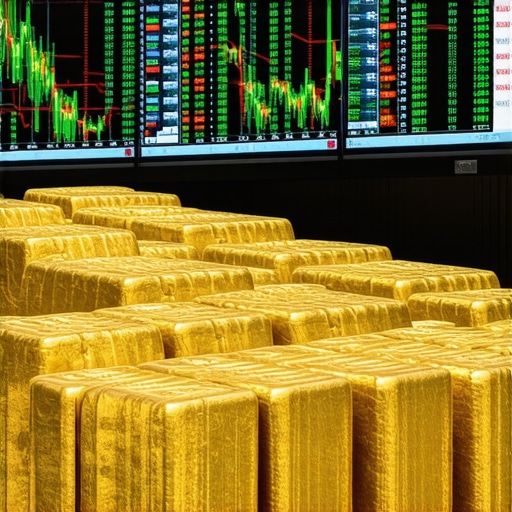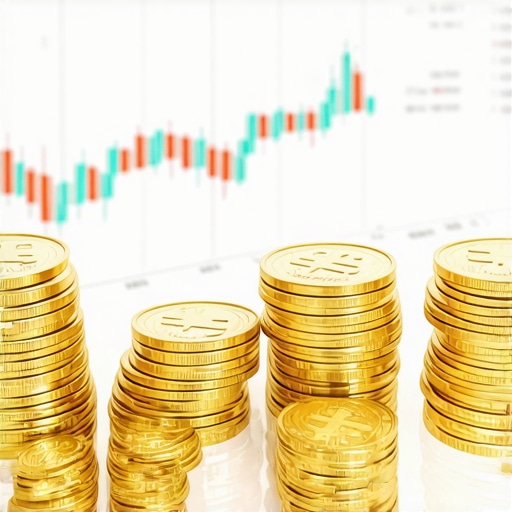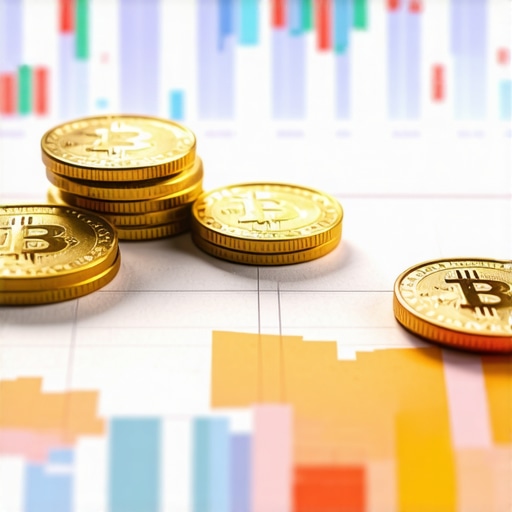Unveiling the Future: An Expert Perspective on the 2025 Gold Market Outlook
The global gold market stands at a pivotal juncture, shaped by a confluence of macroeconomic, geopolitical, and technological factors. As we approach 2025, understanding these complex dynamics is essential for investors, policymakers, and industry stakeholders aiming to optimize their strategies in this resilient asset class. This analysis synthesizes current data, emerging trends, and expert forecasts to provide a comprehensive view of what the future holds for gold.
Deciphering the Macro Drivers: Inflation, Central Banks, and Economic Stability
One of the defining features of the 2025 gold market will be its response to inflationary pressures and monetary policies. Historically, gold has served as a reliable hedge against inflation and currency devaluation. With global inflation rates fluctuating amid post-pandemic recovery efforts, central banks’ gold purchasing strategies will significantly influence price trajectories. Notably, countries like China and Russia have increased their gold reserves, signaling a shift towards diversification away from the US dollar, which could underpin upward price momentum (source).
The Role of Geopolitical Tensions and Supply Chain Disruptions
Geopolitical uncertainties, including ongoing conflicts and trade tensions, will likely heighten gold’s appeal as a safe-haven asset. Additionally, supply chain disruptions—particularly in mining and refining—may constrain supply, pushing prices higher. The interplay between demand for jewelry, investment products, and technological applications (such as electronics) will create nuanced supply-demand equilibria that market analysts need to monitor closely.
Technological Innovations and New Investment Vehicles
Advancements in blockchain and digital asset infrastructure are revolutionizing gold investment. The proliferation of gold-backed ETFs and the emergence of digital gold platforms will democratize access while increasing liquidity. Strategic investors should consider these vehicles as part of a diversified portfolio, especially given the increased transparency and security they offer (source).
What is the most effective way to leverage gold futures and technical analysis in 2025 to maximize returns?
Expert traders recommend integrating gold futures with advanced technical analysis tools, such as moving averages and momentum indicators, to identify optimal entry and exit points. Staying attuned to macroeconomic signals and central bank policies will enhance predictive accuracy. For in-depth strategies, explore our guide on how to use gold futures technical analysis in 2025.
As the gold market evolves, a nuanced understanding of these interconnected factors will be vital. For those seeking to deepen their expertise, engaging with comprehensive market analysis reports and participating in expert forums can provide actionable insights. Consider contributing your perspectives or querying specialized analysts to refine your investment approach.
In conclusion, the 2025 gold market will be characterized by a delicate balance of macroeconomic stability, geopolitical influences, technological innovation, and strategic investments. Keeping abreast of these trends will ensure informed decision-making and long-term wealth preservation.
Harnessing the Power of Gold in a Volatile Market: What Are the Advanced Strategies for 2025?
As we navigate the complexities of the 2025 gold market, investors must adopt sophisticated approaches that go beyond traditional buy-and-hold tactics. Integrating a combination of macroeconomic analysis, technical trading, and emerging financial innovations can significantly enhance returns and mitigate risks. For instance, leveraging derivatives such as gold options and futures, combined with real-time market sentiment analysis, can provide a tactical edge. Experts recommend using tools like futures technical analysis to pinpoint optimal entry points amidst market fluctuations.
How can investors effectively incorporate macroeconomic trends and technical indicators to optimize their gold trading strategies in 2025?
Advanced investors should focus on developing a layered approach: first, monitor macroeconomic indicators such as inflation rates, central bank gold purchases, and geopolitical developments. Concurrently, employ technical analysis tools like Fibonacci retracements, Bollinger Bands, and Relative Strength Index (RSI) to identify short- and medium-term price movements. Combining these dimensions allows for more accurate timing and position sizing, especially during periods of heightened volatility. Moreover, staying informed through authoritative sources like market forecasts can provide context for macro signals. Practically, setting predefined risk thresholds and employing stop-loss orders can protect gains while capitalizing on emerging trends.
Additionally, incorporating emerging financial instruments such as gold ETFs and digital gold platforms can diversify exposure and enhance liquidity. These vehicles often reflect the underlying physical gold’s price movements while offering added flexibility for active strategies. As market dynamics evolve, a nuanced understanding of supply chain disruptions, central bank policies, and technological innovations will be indispensable. For example, recent shifts in supply-demand drivers highlight the importance of staying agile in portfolio management.
To deepen your expertise, explore our comprehensive guide on how to use gold futures technical analysis in 2025, which provides actionable frameworks for strategic trading. Engaging with professional analysis and community forums can also uncover niche opportunities and refine your approach.
By adopting these sophisticated strategies, investors can better navigate the uncertainties of the gold market in 2025, ensuring their portfolios are resilient, diversified, and positioned for growth.
Harnessing Data Analytics and Machine Learning to Forecast Gold Price Trends in 2025
As the gold market becomes increasingly complex, leveraging cutting-edge data analytics and machine learning models offers investors a strategic advantage. These tools can analyze vast datasets—ranging from macroeconomic indicators to social sentiment—and identify subtle patterns that traditional methods might overlook. For example, predictive models such as Random Forests or Gradient Boosting Machines can incorporate variables like inflation rates, central bank reserve changes, geopolitical events, and even social media sentiment to generate probabilistic forecasts of gold price movements (source).
What are the most effective machine learning techniques for gold price prediction in 2025?
Experts often recommend ensemble methods, including Random Forests and XGBoost, due to their robustness and ability to handle nonlinear relationships. Deep learning architectures, particularly Long Short-Term Memory (LSTM) networks, are also well-suited for time-series forecasting, capturing temporal dependencies and market cycles. Integrating these models with real-time data feeds and macroeconomic indicators enables dynamic, adaptive forecasts, which are crucial in volatile environments. To implement these techniques, investors should consider platforms like Python’s scikit-learn and TensorFlow, complemented by cloud computing resources for scalability.
Incorporating ESG Factors and Sustainability Metrics into Gold Investment Strategies
The rising importance of Environmental, Social, and Governance (ESG) criteria is reshaping traditional investment paradigms. In 2025, a sophisticated approach involves assessing the sustainability practices of gold mining companies, which can influence supply stability and long-term valuation. Certifications such as Responsible Gold Mining Principles (RGMP) and adherence to standards set by organizations like the Responsible Minerals Initiative (RMI) provide transparency and risk mitigation. Investors integrating ESG metrics into their valuation models can better anticipate regulatory shifts, reputational risks, and supply chain disruptions, ultimately refining their strategic positioning.
How do ESG considerations influence the risk profile of gold investments in 2025?
ESG factors can mitigate risks associated with regulatory penalties, community conflicts, and environmental liabilities. For instance, mining operations with strong ESG credentials are less likely to face shutdowns or legal challenges, ensuring more stable supply and reducing volatility. Conversely, neglecting ESG considerations may expose portfolios to reputational damage and sudden supply shocks, which can cause abrupt price swings. Incorporating ESG scores into quantitative models allows investors to quantify these risks and make more informed decisions.
Emerging Regulatory Frameworks and Their Impact on the Gold Market
Anticipating regulatory developments is vital for strategic positioning. In 2025, new frameworks aimed at increasing transparency and combating illicit trade—such as the European Union’s due diligence directives—will influence supply chains and pricing. Additionally, potential reforms in tax policies and import/export controls can alter market dynamics. Staying ahead requires continuous monitoring of legislative changes and engaging with industry advocacy groups. Experts suggest that developing adaptable compliance strategies and fostering relationships with regulatory bodies can provide a competitive edge.
What proactive measures can investors take to mitigate regulatory risks in the evolving gold market?
Proactive strategies include diversifying sourcing regions, investing in certified and compliant supply chains, and utilizing blockchain technology for traceability. Regularly consulting legal and compliance experts ensures adherence to emerging standards. Moreover, participating in industry forums and policy discussions positions investors to influence and anticipate regulatory shifts, minimizing adverse impacts.
To deepen your understanding of these advanced strategies, explore our comprehensive resources and connect with industry analysts through webinars and expert forums. Staying informed and adaptable is essential for mastering the intricacies of the 2025 gold market and securing your investment future.
Harnessing Artificial Intelligence for Precision Gold Trading in 2025
In the rapidly evolving landscape of gold investment, integrating artificial intelligence (AI) and machine learning (ML) techniques offers a transformative edge. Sophisticated algorithms can process vast quantities of macroeconomic data, geopolitical signals, and social media sentiment to generate predictive insights with unprecedented accuracy. Utilizing AI-driven models such as neural networks and reinforcement learning allows traders to adapt dynamically to market shifts, optimizing entry and exit points in real-time.
What are the cutting-edge AI tools shaping gold investment strategies in 2025?
Leading platforms incorporate deep learning architectures like LSTM networks for time-series forecasting, complemented by natural language processing (NLP) algorithms that analyze news and social media feeds for sentiment shifts. These tools can identify emerging patterns and anomalies that may precede price movements, enabling investors to act proactively. As per recent research published in The Journal of Financial Data Science, AI-enhanced models have demonstrated significant improvements in predictive accuracy over traditional methods, especially during periods of heightened volatility (source).
How can AI integration revolutionize risk management for gold portfolios?
AI systems facilitate advanced risk analytics, enabling real-time scenario analysis and stress testing. They can dynamically adjust portfolio allocations based on predictive risk indicators, thereby reducing exposure during downturns. Furthermore, AI-driven alerts can notify investors of potential market disruptions, allowing for swift hedging or rebalancing. Incorporating AI into risk management frameworks thus elevates strategic resilience and agility in the face of unpredictable geopolitical and economic developments.
Exploring Blockchain Innovations to Enhance Gold Investment Transparency and Security
The advent of blockchain technology is redefining the security and traceability of gold assets. Digital certificates and tokenized gold enable fractional ownership and seamless transferability, reducing counterparty risk and transaction costs. Industry leaders are deploying blockchain platforms that provide immutable records of gold provenance, aligning with ESG and compliance standards. This transparency not only mitigates fraud but also attracts institutional investors seeking verifiable, liquid exposure to gold.
How do blockchain-based gold tokens influence liquidity and regulatory compliance?
Blockchain tokens facilitate 24/7 trading on global platforms, significantly enhancing liquidity and market accessibility. They streamline regulatory compliance through transparent audit trails, simplifying due diligence processes. As regulatory frameworks evolve, integrating blockchain solutions ensures adherence to anti-money laundering (AML) and know-your-customer (KYC) standards, fostering trust among stakeholders. For investors, this technological shift translates into more efficient, compliant, and flexible investment avenues.
What are the implications of integrating AI and blockchain for institutional gold investors?
Combining AI and blockchain technologies creates a comprehensive ecosystem that enhances operational efficiency, transparency, and predictive capacity. Institutional investors can leverage AI for strategic decision-making while utilizing blockchain for secure settlement and provenance verification. This synergy reduces operational risks, accelerates transaction processing, and aligns with global ESG mandates. As the gold market continues to mature technologically, early adoption of these innovations offers a competitive advantage, positioning firms at the forefront of the digital transformation in precious metals investing.
Stay ahead in the dynamic 2025 gold market by embracing these advanced technological strategies. Engaging with expert analyses, participating in industry forums, and continuously refining your AI and blockchain integrations will ensure your portfolio remains resilient and poised for growth amid ongoing market complexities.
Expert Insights & Advanced Considerations
1. The integration of AI and machine learning is transforming gold price forecasting, enabling more precise predictions amid market volatility.
Advanced analytics and AI models like neural networks and ensemble methods are now essential tools for sophisticated investors aiming to stay ahead of market shifts. Leveraging these technologies enhances risk management and strategic decision-making in the dynamic 2025 landscape.
2. ESG factors are increasingly impacting gold valuation, with sustainable mining practices and transparent supply chains becoming critical for long-term investment stability.
Incorporating ESG metrics into valuation models helps mitigate regulatory and reputational risks, aligning investment strategies with global sustainability standards and fostering resilient portfolios.
3. Blockchain and digital gold innovations are revolutionizing liquidity and transparency, making gold assets more accessible and secure for institutional and retail investors alike.
Tokenized gold and blockchain-based provenance tracking not only improve compliance but also facilitate fractional ownership and 24/7 trading, expanding market reach and investor confidence.
4. Geopolitical tensions and supply chain disruptions will continue to influence gold prices, emphasizing the importance of diversified sourcing and strategic reserves.
Proactive risk mitigation through diversified supply chains and compliance with evolving regulations is vital for safeguarding assets and optimizing returns in uncertain environments.
5. The rise of AI-driven risk management tools offers real-time scenario analysis and adaptive portfolio adjustments, vital for navigating the complexities of the 2025 market.
Utilizing AI for stress testing and predictive analytics enables investors to maintain agility and resilience against geopolitical and macroeconomic shocks.
Curated Expert Resources
- Gold Market Analysis Reports: Regular publications from industry-leading think tanks provide in-depth insights into macro trends and supply-demand dynamics, essential for strategic planning.
- AI and Machine Learning in Finance: Resources such as the Journal of Financial Data Science offer cutting-edge research on predictive modeling and algorithmic trading techniques applicable to gold markets.
- Sustainable Mining Standards: Guidelines from organizations like the Responsible Minerals Initiative (RMI) ensure transparency and ESG compliance, critical for responsible investing.
- Blockchain and Digital Asset Platforms: Leading platforms like Goldbacked tokens and blockchain provenance tools enhance transparency and liquidity, as documented in industry whitepapers.
Final Expert Perspective
The 2025 gold market is poised at a convergence of technological innovation, sustainability imperatives, and geopolitical shifts. Harnessing advanced tools like AI-driven analytics, ESG integration, and blockchain transparency will be pivotal for investors seeking to optimize returns and mitigate risks. Staying informed through authoritative resources and engaging with expert communities will deepen strategic insights and reinforce your position in this evolving landscape. For experienced investors and professionals, continuous learning and adaptation remain the keys to thriving amidst market uncertainties. We invite you to explore these resources further, contribute your expertise, and participate in shaping the future of gold investment strategies—because in this arena, knowledge truly translates into resilience and growth.










